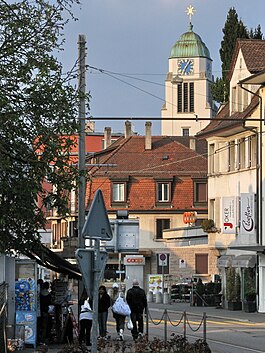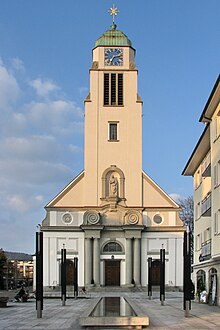| Dietikon | |
|---|---|
| Municipality | |
 | |
 Flag Flag Coat of arms Coat of arms | |
| Location of Dietikon | |
  | |
| Coordinates: 47°24′N 8°24′E / 47.400°N 8.400°E / 47.400; 8.400 | |
| Country | Switzerland |
| Canton | Zurich |
| District | Dietikon |
| Government | |
| • Executive | Stadtrat with 7 members |
| • Mayor | Stadtpräsident Otto Müller (as of March 2014) |
| • Parliament | Gemeinderat with 36 members |
| Area | |
| • Total | 9.33 km (3.60 sq mi) |
| Elevation | 388 m (1,273 ft) |
| Population | |
| • Total | 27,236 |
| • Density | 2,900/km (7,600/sq mi) |
| Time zone | UTC+01:00 (Central European Time) |
| • Summer (DST) | UTC+02:00 (Central European Summer Time) |
| Postal code(s) | 8953 |
| SFOS number | 0243 |
| ISO 3166 code | CH-ZH |
| Surrounded by | Bergdietikon (AG), Geroldswil, Oetwil an der Limmat, Schlieren, Spreitenbach (AG), Unterengstringen, Urdorf, Weiningen |
| Twin towns | Kolín (Czech Republic), Braggio (Switzerland), Renens (Switzerland) |
| Website | www SFSO statistics |
Dietikon is the fifth biggest city of the canton of Zürich in Switzerland, after Zürich, Winterthur, Uster and Dübendorf. It is the capital of the same-named district of Dietikon and part of the Zürich metropolitan area.
Geography


The industrial city Dietikon is situated at an elevation of 388 m (1,273 ft) at the confluence of the Reppisch and the Limmat, located in the Limmat Valley (German: Limmattal), along the railway line from Zürich to Baden. Here and in the neighboring region, Spreitenbach, is also the large Limmattal rail freight marshalling yard.
Dietikon has an area of 9.3 square kilometers (3.6 sq mi). Of this area, 17.2% is used for agricultural purposes, while 27% is forested. Of the rest of the land, 49.1% is settled (buildings or roads) and the remainder (6.7%) is non-productive (rivers, glaciers or mountains). In 1996 housing and buildings made up 33.8% of the total area, while transportation infrastructure made up the rest (15.3%). Of the total unproductive area, water (streams and lakes) made up 4.9% of the area. As of 2007 40.7% of the total municipal area was undergoing some type of construction.
The largest and best known forests of the municipality include the Honeret, Guggenbüehl and Röhrenmoos.
The Honeret forest lies on a side moraine of the Linth glacier ("Linthgletscher"). There are over 200 prominent stones through the woods, up to erratic boulders as big as 25 m (270 sq ft). The Honeret and the Guggenbüehl-Wald are separated by only one main street. In the forest, there are a few springs from which the brooks Tobelbach and Stoffelbach rise and then flow down into the Reppisch. Also in the forest lies the forest cottage "Lorenzhütte."
The Guggenbüehl forest lies wholly within Dietikon. Within the forest lies the "Giigelibode" pond. It has neither inflow nor outflow. A Vita course is in the forest.
Transportation


The municipality is located on the A3 motorway.
Dietikon railway station and Glanzenberg railway station are stops of the S-Bahn Zürich on the lines S3 and S12. Dietikon railway station is also the terminus of the line S17 provided by the Bremgarten-Dietikon-Bahn.
Between 1900 and 1928, Dietikon was the terminus of the Limmattal tramway from Zürich. The Limmattal light rail line follows a similar alignment, albeit extended through Dietikon to Killwangen.
Waters
| This section does not cite any sources. Please help improve this section by adding citations to reliable sources. Unsourced material may be challenged and removed. (August 2024) (Learn how and when to remove this message) |
Important running waters that flow through Dietikon are the Limmat and its tributary Reppisch. Wide brooks are the approximately 3 km (1.9 mi) long Schäflibach and the Teischlibach. The Schäflibach is created with the flows together from Allmendbach and Stockacherbach and leads into the Limmat. The Teischlibach originates from Röhrenmoos in the forest above Dietikon and also leads into the Limmat. The Marmoriweiher lies in the Grunschen a place used for gaming and grilling. The Marmoriweiher is an artificial pond, that was positioned for the water supply of the fire brigade. For this, a distraction canal was built with the Grunschen. Later, the pond of a marble factory served. This gave it its name.
History

Dietikon is first mentioned in 1100 as Dietinchovin. Dietikon features several Roman ruins and also the Fahr Benedictine Convent, given by the House of Regensberg around 1130 AD, with a cloister church dating from the years 1743 to 1746. The Second Battle of Zürich was fought in Dietikon (September 1799) and the town name is among those inscribed at the pillar of the Arc de Triomphe in Paris, France.
Politics
Demographics




Dietikon has a population (as of 31 December 2020) of 28,057. As of 2007, 39.8% of the population was made up of foreign nationals. As of 2008 the gender distribution of the population was 50% male and 50% female. Over the last 10 years the population has grown at a rate of 10.5%. Most of the population (as of 2000) speaks German (73.9%), with Italian being second most common (8.9%) and Albanian being third (3.8%).
In the 2007 election the most popular party was the SVP which received 40.1% of the vote. The next three most popular parties were the SPS (19.9%), the CVP (13.7%) and the FDP (8%).
The age distribution of the population (as of 2000) is children and teenagers (0–19 years old) make up 21.3% of the population, while adults (20–64 years old) make up 64.7% and seniors (over 64 years old) make up 14%. In Dietikon about 60.1% of the population (between age 25-64) have completed either non-mandatory upper secondary education or additional higher education (either university or a Fachhochschule). There are 9,892 households in Dietikon.
Dietikon has an unemployment rate of 4.2%. As of 2005, there were 179 people employed in the primary economic sector and about 13 businesses involved in this sector. 2,613 people are employed in the secondary sector and there are 213 businesses in this sector. 10,632 people are employed in the tertiary sector, with 957 businesses in this sector. As of 2007 60.6% of the working population were employed full-time, and 39.4% were employed part-time.
As of 2008 there were 8,655 Catholics and 4,599 Protestants in Dietikon. In the 2000 census, religion was broken down into several smaller categories. From the 2000 census, 26.5% were some type of Protestant, with 24.6% belonging to the Swiss Reformed Church and 1.9% belonging to other Protestant churches. 41.8% of the population were Catholic. Of the rest of the population, 12.2% were Muslim, 16.1% belonged to another religion (not listed), 4.6% did not give a religion, and 9.4% were atheist or agnostic.
The historical population is given in the following table:
| year | population |
|---|---|
| 1779 | 686 |
| 1836 | 1,025 |
| 1850 | 1,291 |
| 1900 | 2,613 |
| 1910 | 4,493 |
| 1950 | 7,132 |
| 1960 | 14,920 |
| 1970 | 22,705 |
| 1990 | 21,152 |
| 2000 | 21,353 |
| 2017 | 27,079 |
Economics and education
Among other companies, the Limmattaler Zeitung newspaper and Ex Libris are situated in Dietikon.
Weather
Dietikon has an average of 132.2 days of rain per year and on average receives 1,078 mm (42.4 in) of precipitation. The wettest month is August during which time Dietikon receives an average of 114 mm (4.5 in) of precipitation. During the wettest month, there is precipitation for an average of 12.7 days.
Visitor attractions
There's the Bruno Weber Park in Dietikon respectively Spreitenbach, one of the few sculpture gardens and Gesamtkunstwerks in Switzerland. Glanzenberg was once a settlement along the river Limmat, but its fortifications seem to never have been completed, and it might have been destroyed in 1267/68, a legend tells. Its remains are to be found in a little forest along the Limmat, opposite the railway station of the same name. Also situated there are the walls of the former Glanzenberg castle, built in the late 12th century AD by the Counts of Regensberg.
Notable people

- Bruno Weber (1931-2011) an artist and architect, specializing in fantastic realism
- Peter Schweri (1939-2016) artist, painter, illustrator, photographer and music composer
- Peter Vetsch (born 1943) an architect, known for building earth houses
- Urs Fischbacher (born 1959) an economist and professor of applied economic research at the University of Konstanz
- Markus Notter (born 1960) politician and former city president
- Josef Wiederkehr (born 1970) a businessman and politician
- Diamá (born 1980) also known as Claudia D'Addio, a singer, grew up in Dietikon
Twin towns
Dietikon is twinned with the towns of
|
Gallery
-
 Zentralschulhaus building
Zentralschulhaus building
-
 Zürcherstrasse towards Schlieren
Zürcherstrasse towards Schlieren
-
 Protected area Dietiker & Geroldswiler Auen on the Limmat's shore
Protected area Dietiker & Geroldswiler Auen on the Limmat's shore
-
 Hiking path at Glanzenberg train station
Hiking path at Glanzenberg train station
-
Ruins of the Schönenwerd water castle
-
 Dietikon as part of the inscription at the Arc de Triomphe in Paris referring to the Second Battle of Zürich in 1799
Dietikon as part of the inscription at the Arc de Triomphe in Paris referring to the Second Battle of Zürich in 1799
-
Bruno Weber Park
-
Earth house estate Lättenstrasse by Peter Vetsch
References
- ^ "Arealstatistik Standard - Gemeinden nach 4 Hauptbereichen". Federal Statistical Office. Retrieved 13 January 2019.
- "Ständige Wohnbevölkerung nach Staatsangehörigkeitskategorie Geschlecht und Gemeinde; Provisorische Jahresergebnisse; 2018". Federal Statistical Office. 9 April 2019. Retrieved 11 April 2019.
- ^ Swiss Federal Statistical Office Archived January 5, 2016, at the Wayback Machine accessed 05-Aug-2009
- ^ Statistics Zurich (in German) accessed 4 August 2009
- "Das kurze Leben des "Lisebethli"" [The short life of «Lisebethli»]. Neue Zürcher Zeitung (in German). 18 February 2002. Archived from the original on 28 November 2018. Retrieved 28 November 2018.
- "Betrieb & Angebot" [Operation & Offer] (in German). Limmattalbahn AG. Archived from the original on 31 May 2018. Retrieved 31 May 2018.
- ^ Dietikon in German, French and Italian in the online Historical Dictionary of Switzerland.
- "Ständige und nichtständige Wohnbevölkerung nach institutionellen Gliederungen, Geburtsort und Staatsangehörigkeit". bfs.admin.ch (in German). Swiss Federal Statistical Office - STAT-TAB. 31 December 2020. Retrieved 21 September 2021.
- "Temperature and Precipitation Average Values-Table, 1961-1990" (in German, French, and Italian). Federal Office of Meteorology and Climatology - MeteoSwiss. Archived from the original on 27 June 2009. Retrieved 8 May 2009., the weather station elevation is 385 meters above sea level.
- Kathrin Fink (2014-08-31). "Künstlerfreunde glauben fest an die Zukunft des Bruno-Weber-Parks" (in German). Limmattaler Zeitung. Archived from the original on 2016-03-04. Retrieved 2014-10-17.
External links
- Official website (in German)
- Dietikon in German, French and Italian in the online Historical Dictionary of Switzerland.
| Municipalities in the district of Dietikon, Switzerland | ||
|---|---|---|